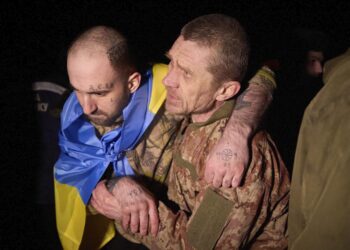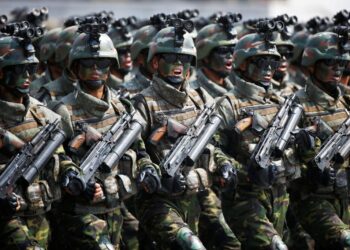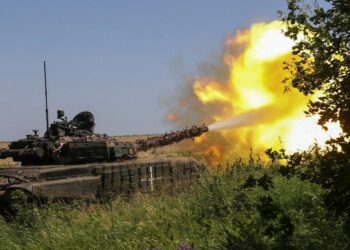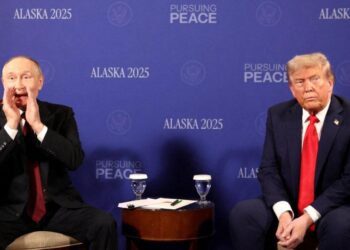In the heart of Europe, a battle rages that transcends borders and echoes through the annals of history. The ongoing conflict in Ukraine has become a formidable challenge for the continent, compelling European nations to grapple not only with their traditional security paradigms but also with the moral imperative of supporting a nation under siege. As Kyiv strives to fend off aggression,European leaders face the daunting task of maintaining military and financial aid while navigating the treacherous landscape of geopolitical rivalry and domestic pressures. This article delves into the complexities of Europe’s involvement in the war, examining the delicate balance between supporting Ukraine’s sovereignty and ensuring the security of the continent itself. with stakes higher than ever, the actions taken—or not taken—by European countries could have profound implications for the future of both Ukraine and the broader geopolitical landscape in Europe.
Europe’s Commitment to kyiv: Assessing the Current Landscape of Support
As the war in Ukraine continues, European nations face a dual challenge: providing unwavering support to kyiv while ensuring their own national security. Over the past months, many european leaders have signaled an intention to increase military aid, diplomatic support, and economic assistance to Ukraine. This commitment is evidenced by the growing military donations,which include advanced weaponry and battlefield supplies,and also humanitarian aid flows to aid displaced populations. Key players in this commitment include:
- Germany: Providing Leopard tanks and financial support.
- France: Supplying artillery systems and training troops.
- poland: Facilitating logistical support and hosting ukrainian refugees.
European nations are also revamping their defense policies, recognizing the need for enhanced military readiness in the face of increased threats from Russia. Strategic alliances are being formulated, with coordinated defense exercises and intelligence sharing emerging as critical components of the European response.The dynamics of this support landscape can be encapsulated in the following table:
| Country | Type of Support | Recent Initiatives |
|---|---|---|
| Germany | Military & Financial | Leopard tanks delivery |
| France | Military | Training ukrainian troops |
| Poland | Humanitarian | Hosting refugees |
This interconnected web of support underscores the profound implications of Europe’s commitment to Ukraine, not only for Kyiv’s resilience but also for the continent’s strategic stability as a whole. As the situation evolves, the balance between maintaining this supportive framework and managing domestic challenges will remain a focal point for European leaders, shaping the future of both regional security and collective geopolitical stance.
The Strategic Importance of Ukraine: implications for European Security
The ongoing conflict in Ukraine has emerged as a pivotal juncture for European security, reshaping the geopolitical landscape of the continent. The war has underscored the interdependence between regional stability and the fate of Ukraine, emphasizing the necessity for a unified European response. As Ukraine’s struggles highlight the threat posed by aggressive nationalistic policies, European nations are compelled to reassess their security strategies and military alliances. This situation presses them to consider the following implications:
- Enhanced Military Cooperation: Increased joint exercises and defense initiatives among NATO member states are vital to bolstering collective resilience.
- Strategic Energy Independence: the need to reduce reliance on Russian energy supplies has never been more urgent, prompting investments in renewable energy sources and option energy partners.
- Heightened Cybersecurity Measures: As digital domains become battlegrounds, nations must fortify their cyber defenses to protect critical infrastructure.
Moreover, the conflict has catalyzed a reevaluation of defense spending across Europe, with many countries now prioritizing military readiness and modernization.The uncertainty surrounding the conflict obliges European leaders to craft a comprehensive strategy that balances diplomatic negotiations with robust support for Ukraine. to quantify the extent of this shift, consider the following table that illustrates recent changes in defense budgets among key European nations:
| Country | 2023 Defense Budget (USD Billion) | Percentage Change from 2022 |
|---|---|---|
| Germany | 61.0 | +6.5% |
| france | 55.0 | +4.8% |
| Poland | 19.0 | +10.0% |
| Italy | 30.0 | +3.2% |
Challenges Facing Europe: Balancing Military and Economic Aid to Ukraine
The conflict in Ukraine has placed Europe in a precarious position, necessitating a delicate equilibrium between providing military support and addressing the pressing economic vulnerabilities that arise from prolonged warfare. As the European Union grapples with the complexities of this dual commitment, the following factors have emerged as notable challenges:
- Resource Allocation: Balancing military expenditures with necessary economic assistance to both Ukraine and domestic priorities.
- Public Opinion: Navigating rising war fatigue among European citizens who may support economic aid but question the extent of military involvement.
- geopolitical Ramifications: Recognizing the broader implications of military aid on relations with Russia and the potential for escalation.
Furthermore, European nations must contend with the immediate economic fallout resulting from the conflict, including energy price spikes and supply chain disruptions. In addressing these challenges, countries are exploring various strategies, as highlighted in the table below:
| Strategy | Description |
|---|---|
| Increased Defense Budgets | Elevating military spending to strengthen national and collective security. |
| Economic Sanctions | Implementing sanctions against Russia while supporting affected industries in Europe. |
| Joint procurement Initiatives | Collaboration among EU states to procure resources and armaments efficiently. |
The Role of NATO: Strengthening Collective Defense in the Face of Aggression
The ongoing conflict in Ukraine has underscored the vital importance of NATO as a bulwark against acts of aggression. Founded on the principle of collective defense, the alliance ensures that an attack on one member is considered an attack on all. This mutual commitment strengthens not only military readiness but also fosters political solidarity among member nations. key elements contributing to NATO’s role in this context include:
- Deterrence Strategies: By maintaining a robust presence and demonstrating military capabilities, NATO deters potential aggressors from underestimating its resolve.
- Interoperability: Joint exercises and shared defense protocols enhance collaboration among member states’ armed forces, making them more effective in responding to threats.
- Support for Ukraine: NATO provides military assistance and strategic guidance to Ukraine, reinforcing its sovereignty and sovereignty against external pressure.
NATO’s response to the crisis in ukraine has highlighted its evolving role in modern defense alliances. Member nations have rallied not only around traditional military support but also through diplomatic channels and economic sanctions against aggressors. The following table illustrates the multifaceted approach NATO employs in response to the current challenges:
| Strategy | Description |
|---|---|
| Military Presence | Deploying additional troops and resources to border states to deter potential threats. |
| Training Missions | Providing training for Ukrainian forces to enhance their defense capabilities. |
| Intelligence Sharing | Coordinating intelligence operations to monitor and counteract aggressive maneuvers. |
Public Sentiment and Political Will: Navigating Domestic Pressures in Europe
The ongoing conflict in Ukraine has become a litmus test for European unity and resilience.As Member States grapple with the ramifications of their support for Kyiv, public opinion has emerged as a critical factor shaping political calculations. In many nations, citizens directly impact governmental decisions through vocal advocacy, protests, and grassroots movements. This dynamic presents both opportunities and challenges, as leaders must balance the desire for robust assistance to Ukraine with the domestic pressures arising from economic hardships and political dissent.Key factors influencing public sentiment include:
- The economic implications of sanctions against Russia and rising energy prices.
- Humanitarian concerns over the plight of Ukrainian refugees.
- National security debates focusing on the direct threats posed by Russian aggression.
Concurrently, the political landscape across Europe reflects a spectrum of commitment levels toward Ukraine. In recent polls, a noticeable divergence emerged between countries most affected by the conflict and those less engaged. Political leaders are increasingly aware that their electorate’s support can evaporate as costs rise. To navigate this complex situation, several governments are implementing nuanced strategies to sustain backing for Ukraine while addressing domestic discontent. A recent survey indicates that:
| Country | Support for Ukraine (%) | Concern Over Economic Impact (%) |
|---|---|---|
| Germany | 68 | 72 |
| France | 65 | 70 |
| Italy | 58 | 78 |
| Poland | 82 | 64 |
This data underscores the urgent need for European leaders to engage with their constituents to craft a sustainable path forward—one that supports Ukraine in its fight while also addressing the legitimate concerns of their citizens. Building a cohesive vision that balances foreign policy objectives with domestic expectations is essential for maintaining both unity and resolve within Europe as the conflict unfolds.
Innovative Strategies for Sustained Support: Leveraging Financial and Human Resources
To effectively bolster Ukraine’s resilience amidst the ongoing conflict, european nations must embrace a dual-pronged approach that melds financial investment with robust human resource mobilization. By prioritizing direct financial assistance to Kyiv, European leaders can ensure that essential services and military capabilities remain operational. this support can take various forms, including:
- Grants and Loans: Offering flexible financial instruments to sustain Ukraine’s economy and facilitate defense procurements.
- Infrastructure Investment: funding critical infrastructure repairs to enhance both civilian life and military logistics.
- Joint Procurement Initiatives: Coordinating procurement strategies to reduce costs on military supplies for Ukraine.
Simultaneously, the mobilization of human resources is crucial. The continent needs to harness its expertise and workforce to provide training and support. This includes the establishment of training programs for Ukrainian military personnel and leveraging civilian skilled labor in strategic sectors. Possible initiatives might encompass:
| Initiative | Description |
|---|---|
| Military Training Programs | Advanced tactics and strategy training for Ukrainian forces. |
| Technical Assistance Workshops | Workshops aimed at enhancing local manufacturing capabilities. |
| Volunteer Integration | Mobilizing volunteers from across Europe to support humanitarian needs. |
By integrating these strategies, Europe can not only provide immediate aid but also lay the groundwork for long-term stability and support for Ukraine, reinforcing its strategic position while simultaneously enhancing its own defensive capabilities against potential threats. The challenge lies in coordinating these efforts across diverse nations with differing priorities and capacities,necessitating collaboration and commitment at multiple levels.
Building a Resilient Ukraine: Fostering Civil Society and Governance reforms
In the wake of ongoing conflict, a robust civil society emerges as a cornerstone of Ukraine’s resilience. Local communities, NGOs, and grassroots movements are instrumental in fostering solidarity and mobilizing citizens towards common goals. key components include:
- Empowerment of local organizations: These groups serve as a bridge between the goverment and citizens, advocating for their needs and ensuring accountability.
- Volunteerism and civic engagement: The rise of volunteer initiatives showcases the dedication of Ukrainians who rally to support their fellow citizens during crises.
- Promotion of culture and education: Civil society plays a pivotal role in preserving national identity and educating future generations about democracy and civic responsibility.
Effective governance reforms are equally critical. They address systemic issues that undermine the state’s capacity to respond to challenges and enhance public trust. Essential reform areas include:
- Judicial independence: Strengthening the judiciary ensures fairness and combats corruption, fostering a climate of trust in public institutions.
- Decentralization of power: By empowering local governments, reforms facilitate tailored solutions that address the unique needs of diverse regions.
- Integration of technology: E-governance initiatives streamline processes, enhance openness, and improve citizen engagement.
| Reform Area | Objective |
|---|---|
| Judicial Independence | Ensure a fair legal system |
| Decentralization | Empower local governments |
| E-Governance | Enhance transparency and efficiency |
Lessons from History: Learning from Past Conflicts to Inform current Responses
The ongoing conflict in Ukraine serves as a critical reminder of the darker lessons from Europe’s past. Historical conflicts, particularly those stemming from the World Wars, teach us about the meaning of unity and decisive action among nations. In both global conflicts,the failure to act cohesively frequently enough resulted in prolonged suffering and destabilization. Contemporary Europe must heed these warnings, rallying support not just politically but also militarily for Ukraine. Additionally, it must learn the importance of grassroots support for its strategic objectives, recognizing that public sentiment can greatly influence the success of diplomatic and military efforts.
Moreover, past conflicts highlight the necessity of strategic foresight. The interwar period serves as a cautionary tale, demonstrating how neglect and complacency can lead to devastating consequences.european nations today must prioritize sustained engagement with Ukraine, avoiding a repeat of history where half-hearted commitments eroded morale and resolve. Integrating lessons on economic sanctions and national resilience is essential, with a focus on creating frameworks that ensure long-term stability both in Ukraine and across the continent. A historical perspective not only informs tactical decisions but lays the groundwork for a more unified European response to aggression.
The Consequences of Inaction: Understanding the Risks of a Weakened ukraine
The ongoing conflict in Ukraine presents not only a humanitarian crisis but also a series of geopolitical risks for Europe and beyond. Failing to provide adequate support to a beleaguered Ukraine could lead to serious implications, including the resurgence of aggressive russian ambitions in Eastern Europe. A weakened Ukraine might embolden adversaries by demonstrating that international commitments can be evaded without result. The fallout could include:
- Increased instability: A crumbling ukrainian defense could trigger a chain reaction of insecurity across Eastern Europe.
- Expansion of authoritarian influence: Neighboring regimes may perceive a moment of opportunity to act more aggressively.
- Humanitarian disasters: Without support, millions could face displacement, exacerbating existing refugee crises in Europe.
Moreover, inaction risks eroding the lessons learned from previous conflicts. A nonchalant approach could reinforce perceptions of European disunity, leading to a prolonged conflict that strains resources and political will. This may manifest in several outcomes, including:
| Outcome | Risk Mitigation Strategies |
|---|---|
| Geopolitical Vacuum | Increase diplomatic engagement in Eastern Europe |
| Military Escalation | Strengthen NATO’s eastern flank |
| Economic Consequences | Implement sanctions and support economic resilience in Ukraine |
This is not merely a question of supporting Ukraine but safeguarding a collective commitment to a stable, democratic Europe. The path policymakers choose now will reverberate for generations to come, demanding a cohesive strategy to avert the dire consequences of inaction.
In Summary
As the conflict in Ukraine continues to reshape the geopolitical landscape of Europe, the stakes have never been higher for both Kyiv and the nations that rally to support it. The intricate balance of providing military aid while ensuring national security presents a formidable challenge for european leaders, who must navigate the complexities of international alliances, public opinion, and economic implications. The successes and failures of this endeavor will not only define Ukraine’s future but will also serve as a litmus test for Europe’s resolve to uphold democratic values and territorial integrity in the face of aggression. As the war grinds on, it remains imperative for Europe to refine its strategies, bolster its defenses, and reaffirm its commitment to a free and sovereign Ukraine.The road ahead is fraught with uncertainty, but the choices made now will resonate for generations to come. With vigilance and solidarity, Europe can rise to meet the challenges of this pivotal moment in history.















